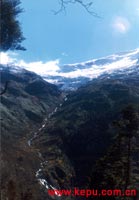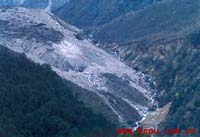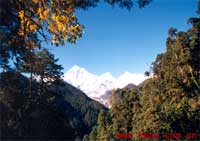Features of Contemporary and Fossil Glaciers
 |
| Thawing ice and snow water flowing into the Great Canyon |
Within the range of the moisture passage under the control of marine climate, Mount Namjagbarwa becomes a center for the cultivation of contemporary glaciers. The southern slope of Mount Namjagbarwa is of a windward slope and it develops three mountain valley glaciers, such as the Yanglangzangbo glacier and Bainongba glacier, which are as long as about 10 kilometers and they even extend to the mingled forests of needle-leaved and broad-leaved trees; the northern and the western slopes of Mount Namjagbarwa each has a mountain valley glacier; the Zelongneng glacier of the western slope is about 10 kilometers long and it is a jerking motion glacier by nature. After more than 10 years observation, we find that this glacier is in a fast thawing movement. It is quite obvious that the glaciers developed with Mount Namjagbarwa as the center have the features of an uneven and unsymmetrical distribution. Jialabailei Peak in the northern side of the canyon is also a center for the development of glaciers. On its eastern slope, a large-sized mountain valley glacier named Liequ glacier is developed. The snow line there is 4700 meters high. The elevation in the end of the glaciers is 2850 meters, where the feed of the glacier is quite abundant.
 |
 |
|
A marine glacier extends to the forests |
A marine glacier extends to the forests |
The lower part of the thawing area is covered with surface maraine hills; thus the dynamic changes are relatively stable. Mount Namjagbarwa faces the passage of the moisture northward and a glacier named Kaqin Glacier, which is 33 kilometers long, is developed there; the Laigu glacier in the upstream of the Parlung Zangbo, is as long as 35 kilometers. They are all the longest mountain valley glaciers of a moderate marine nature in our country. The ends of these glaciers extend to the evergreen broad-leaved forests of the sub-tropical zone. The lowest parts of them may extend to as low as el. 2500 m and such phenomena constitute lots of natural miracles. During the quaternary period, the mountain areas of this part developed many glaciers, which left some complete fossil glacier U-shaped valleys today. Particularly in the U-shaped valley bottom plain affected by the fossil glaciers in the upstream of Bodoi Zangbo in the great canyon region, we can find many maraine hills scattering here and there like tombs. We only know that such kinds of maraine hills only appear on the thawing plains in the front edge of continental glaciers previously. Now, they are found in the bottom of the mountain valley glacier grooves. It is a kind of special piling distribution newly found and it is the piling relic of fossil glacier action under special circumstance in the moisture passage.
|